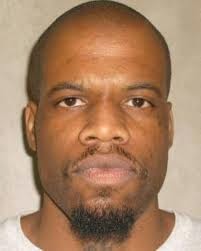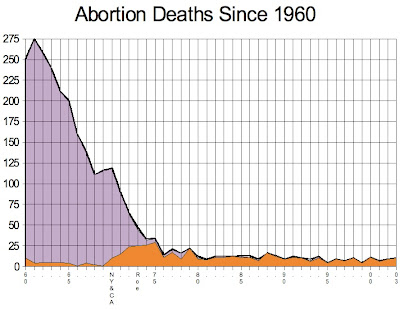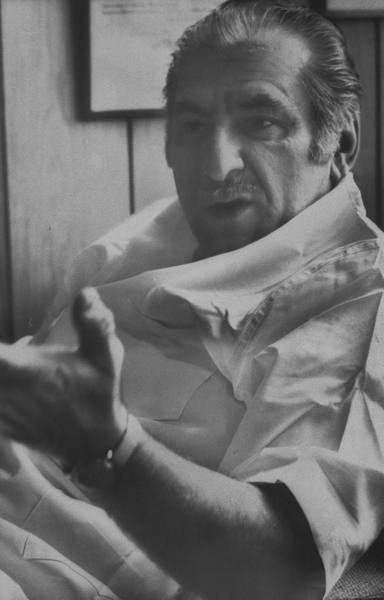Those insist that
legalization of abortion
is necessary to keep our daughters safe might want to speak to
Lou Ann Herron's father, Mike Gibb, who silently wept in the courtroom as he
listened to witnesses describe how his daughter died from a safe-n-legal
abortion.
On April 17, 1998, 33-year-old Lou Ann Herron bled to death after a late abortion at the now defunct A-Z Women's Center.
The Pregnancy
Medical assistant Sylvia Aragon wept on the witness stand as she said
that Lou Ann's pregnancy was "too far along" for an abortion. Aragon
said that she thought abortionist John Biskind kept ordering
more and more ultrasound scans to try to get one that would document the
pregnancy as being early enough for the abortion to be legal.
A total
of seven ultrasounds were done before an estimate of 23 weeks was
obtained the day prior to the abortion. Although Arizona law allows the
abortionist to have final judgment about whether or not the fetus is
viable, and therefore past the legal limit for abortion, the standard
point for viability is believed to be around 24 weeks. The ultrasound
Aragon did on April 9 showed a 26-week fetus.
If the abortion was indeed being done after 24 weeks, Arizona law
requires that two physicians be present. Biskind was the only physician
attending Lou Ann's abortion. Arizona law also limits abortions after 24
weeks to those that an abortionist can try to justify on the grounds
that it was necessary to preserve the health and safety of the mother --
a nonsensical concept, since after 24 weeks a conscientious physician
faced with a gravely ill patient will perform an emergency c-section in a
hospital operating room; he will not perform a risky late abortion in a
freestanding clinic.
There were no health concerns in Lou Ann's case anyway, the prosecution
noted. She sought the abortion because she already had two children and
was separated from her husband.
The Abortion
Prosecutors said that Biskind had ordered a total of seven ultrasounds
performed, with estimates ranging from 23 weeks 3 days to 26 weeks.
However, only the ultrasound that showed the pregnancy as 23 weeks 3
days was forwarded to the medical examiner; the others were lost or
destroyed by the facility. Biskind's defense held that no attempts were
made to fudge ultrasounds, nor were records tampered with or destroyed.
The abortion was performed at 1:30 p.m. Biskind, his lawyer said, noted a
small amount of blood on the sheets when he checked on Lou Ann after
the abortion, but that he was not concerned because bleeding is normal
after an abortion.
The Aftermath
Two medical assistants testified that Lou Ann was very frightened about
her condition as she lay in recovery. She begged, they said, to know
what was wrong with her. She cried out in pain as she lay in a puddle of
blood for three hours. Biskind fixed her IV (complaining that there was
no qualified nurse on staff to do this), reassured her, and left the
building at around 3:45 p.m., according to testimony.
Clinic administrator Carole Stuart-Schadoff had a staffer page Biskind
25 minutes later when Lou Ann's condition worsened. Biskind did not
return to the clinic, but told staff to call 911.
Prosecutors estimate that by the time paramedics were summoned, Lou Ann had lost 2 to 3 litres of blood.
When the rescue crew arrived, Phoenix fire captain Biran Tobin Tobin
testified, Lou Ann was wearing an oxygen mask, but had not been
intubated. There was also no IV in place. "I very quickly felt that
there wasn't a lot of competent medical care going on at the time," he
said.
Tobin testified that Lou Ann appeared to be dead. Nobody at the clinic
seemed aware of how grave her condition was, he said, and nobody seemed
to be helping her in any way. Staff told Tobin that Lou Ann's vitals
were pulse 100, blood pressure 90/50. "It was very difficult for me to
believe that they could get the vital signs of a woman who, even as we
walked in the door, looked really dead," he said.
On cross-examination, Tobin indicated that during the 11 minutes the
rescue crew was at the facility, he personally never touched the
patient. He could not say if her skin was so cold because it was cold at
the facility, or because she was dead.
Biskind surrendered his license to practice medicine in Arizona after
Lou Ann's death in order to stop an ongoing medical board investigation
of the circumstances and his handling of the case.
The Trial
A former Maricopa County medical examiner testified that the tear in
LouAnne's uterus was caused by medical instruments, and not by a fetal
body part as the defense suggested. However, even had the injury been
caused by a fetal body part, this is an expected complication and would
not have excused Biskind from his duty to notice and treat the injury.
 |
| Biskind on trial |
Emergency
room physician John Gallagher testified that, based on his assessment
of Lou Ann's condition, she could have been saved had she been brought
into surgery promptly. This assessment is in keeping with a CDC study
concluding that given the training and resources available to
physicians, no woman need bleed to death from a legal abortion.
Gallagher trains paramedics for the Phoenix Fire Department. He said
that the records he reviewed clearly indicated that Lou Ann's condition
was life threatening as she lay bleeding after her abortion, and that
Biskind should have recognized the severity of her injuries.
Gallagher
testified that the records clearly indicated serious trouble at 1:25
p.m., 16 minutes after Lou Ann had been taken to the recovery room. He
said that had he been treating her, he would have ordered more IV fluids
and blood immediately, and summoned an ambulance to take her to a
hospital where she could be treated in a properly equipped operating
room.
Gallagher noted that during her last hours in the recovery room, Lou Ann
became combative, anxious and frightened, and that she reported her
legs were going numb. These, he noted, are all clear signs of severe
blood loss. Instead of recognizing the danger she was in, Gallagher
noted, Biskind instead tried to calm Lou Ann and reassure her that she
would be "just fine."
Dr. Sidney Wecsler, an abortion expert testifying for the prosecution,
said that the letter Biskind wrote to the medical board describing Lou
Ann's death misrepresented both her condition and his treatment of her.
The letter, dated June 1, 1998, said that Boskind checked on Lou Ann at
1:25 p.m., and that "pulse and blood pressure were satisfactory." The
medical records, however, show that Lou Ann's blood pressue was low at
that time, a symptom of severe blood loss. Biskind also said in the
letter that Lou Ann was alert and talking when he left the clinic at
4:05, which Wecsler said would have been impossible for the moribund
patient who was certainly dead by the time paramedics arrived twenty
minutes later.
Wechsler said that Biskind surely knew as early as 3:15 p.m. that Lou
Ann was not alert, because he ordered a drug to arouse her, which did
not work. Biskind's letter makes no mention of administering this drug.
Biskind's defense has been claiming that the assistants at the clinic
failed to keep Biskind informed of Lou Ann's deteriorating condition.
But Biskind's letter to the medical board claims that he himself checked
on her every 30 to 45 minutes.
Wechsler was cross-examined by Biskind's lawyer. The lawyer contends
that the assistants could have misjudged how much blood Lou Ann was
losing, and that Lou Ann's low blood pressure may have been due to
medication and not hemorrhage. Wechsler didn't budge from his initial
assessment, that Biskind had plenty of evidence and had no legitimate
reason to claim ignorance of Lou Ann's life-threatening condition.
Wechsler said that Biskind should have done a pelvic exam and other
tests to determine exactly what was wrong with Lou Ann as she lay,
frantic and bleeding, in the recovery room. If nothing else, Wechsler
said, the fact that Lou Ann was still in recovery three hours after her
abortion, long after other patients were up and about and discharged
from the facility, should have alerted Biskind to the fact that
something was seriously wrong.
A doctor who specializes in obstetric ultrasounds testified that the
quality of the scan used to justify Lou Ann's abortion was so poor that
it appeared the machine was defective and improperly used. The judge
ordered struck from the record the expert's comment that reading an
ultrasound properly is "a matter of life and death" for an unborn baby.
Biskind's defense was largely based on the idea that no physician would
have rationally have left the facility had he realized that Lou Ann was
in danger of bleeding to death from the hole in her uterus. The defense
also holds that Biskind did not order multiple ultrasounds, but that the
fetus was truly 23 weeks.
The prosecution noted that the clinic charged $1,250 for an abortion
between 20 and 24 weeks, and indicated that it was this fee, and not any
medical concern for Lou Ann, that led Biskind to proceed with an
abortion.
Biskind's attorney also indicated that Biskind informed Lou Ann of the
risks of a late abortion before she signed the consent form.
Biskind's co-defendant, Carole Stuart-Schanoff, had a defense based on
the idea that as administrator of the facility, she had no medical
training, took no role in patients' medical care, and therefore was not
responsible for what happened in the clinic she was running. Prosecutors
point out that Stuart-Schadoff scheduled the abortion, and that she
scheduled it despite knowing that there would be no registered nurse
attending the recovery room that day. The prosection also noted that
Stuart-Schadoff delayed calling 911, choosing to call Biskind first.
Lois Montagno, an RN from the now closed A-Z Women's Center, testified
that she told Stuart-Schadoff a week in advance that she would not be
able to work past noon on August 17, 1998, the day Stuart-Schadoff
scheduled Lou Ann Herron for her fatal abortion. This supports the
prosecution's contention that Stuart-Schadoff was responsible for
leaving Lou Ann in the care of medical assistants, who would not be
qualified to supervise the recovery room.
Montagno also testified that she left a note to remind the supervisor,
and told her as she was leaving on the 17th, reminding Stuart-Schadoff
to tell Biskind that there would be no RN in the recovery room. Montagno
did not tell Biskind she was leaving; she testified that he was in the
procedure room at the time and she did not want to interrupt him.
Upon retiring to deliberate at 1:30 p.m. on Tuesday, the jury of seven
women and one man immediately agreed that the defendants were guilty. It
was simply a matter of deciding which charges they were guilty of: the
manslaughter charge, or the lesser charge of negligent homicide. It took
them 4 1/2 hours to conclude that Biskind was guilty of manslaughter,
Stuart-Schadoff of negligent homicide.
Lou Ann's family, which occupied two rows of the courtroom during the
trial, wept as the verdicts were read. They met with members of the jury
afterward.
Jury foreman Russell Craig, 56, spoke for the jury in the aftermath of
the abortion death trial. He reported that he and other jurors were
haunted by vivid dreams. He was particularly disturbed by the autopsy
photos.
According to Craig, Biskind was his own worst enemy. "At one point when
the prosecutor had finished his closing arguments," Craig told a
reporter, "he applauded. It certainly didn't make much of an
impression."
Only after the trial was over did members of the jury learn of Biskind's history of misconduct, including the previous death of
another abortion patient. Craig said that this information "makes me feel better about my decision."
After the verdict, County Attorney Romley called for tougher laws
addressing the way the Board of Medical Examiners handles doctors with
problems.
The Owner
A-Z owner
Moshe Hachamovitch
testified, news reports say, "reluctantly and under tight security."
When questioned about his knowledge of procedures at the facility, and
about Lou Ann's death, he responded, "I don't remember." He did,
however, indicate that he called Biskind a few weeks after the death to
discuss the case, but did not say what, if any, conclusions he reached
about how the situation was handled.
Hachamovitch admitted that the clinic did not have a procedures manual,
but said that Biskind was "excellent at doing second-trimester
abortions." Hachamovitch indicated that he himself is an expert on late
abortions, having performed "hundreds of thousands of them" during his
41 years of practice, going back to pre-
Roe days in New York.
However, Hachamovitch's license had been suspended in New York for nine
months on the grounds of gross negligence, gross incompetence, and
innacurate patient records. His license was again suspended in New York
for practicing fraugulently and failing to maintain adequate records.
Hachamovitch himself performed the fatal abortions on
Tanya Williamson,
Luz Rodriguez, and
Christina Goesswein.
Jammie Garcia died after a safe and legal abortion at Hachamovitch's Texas facility.

























